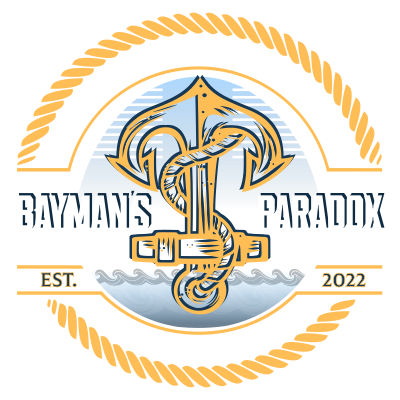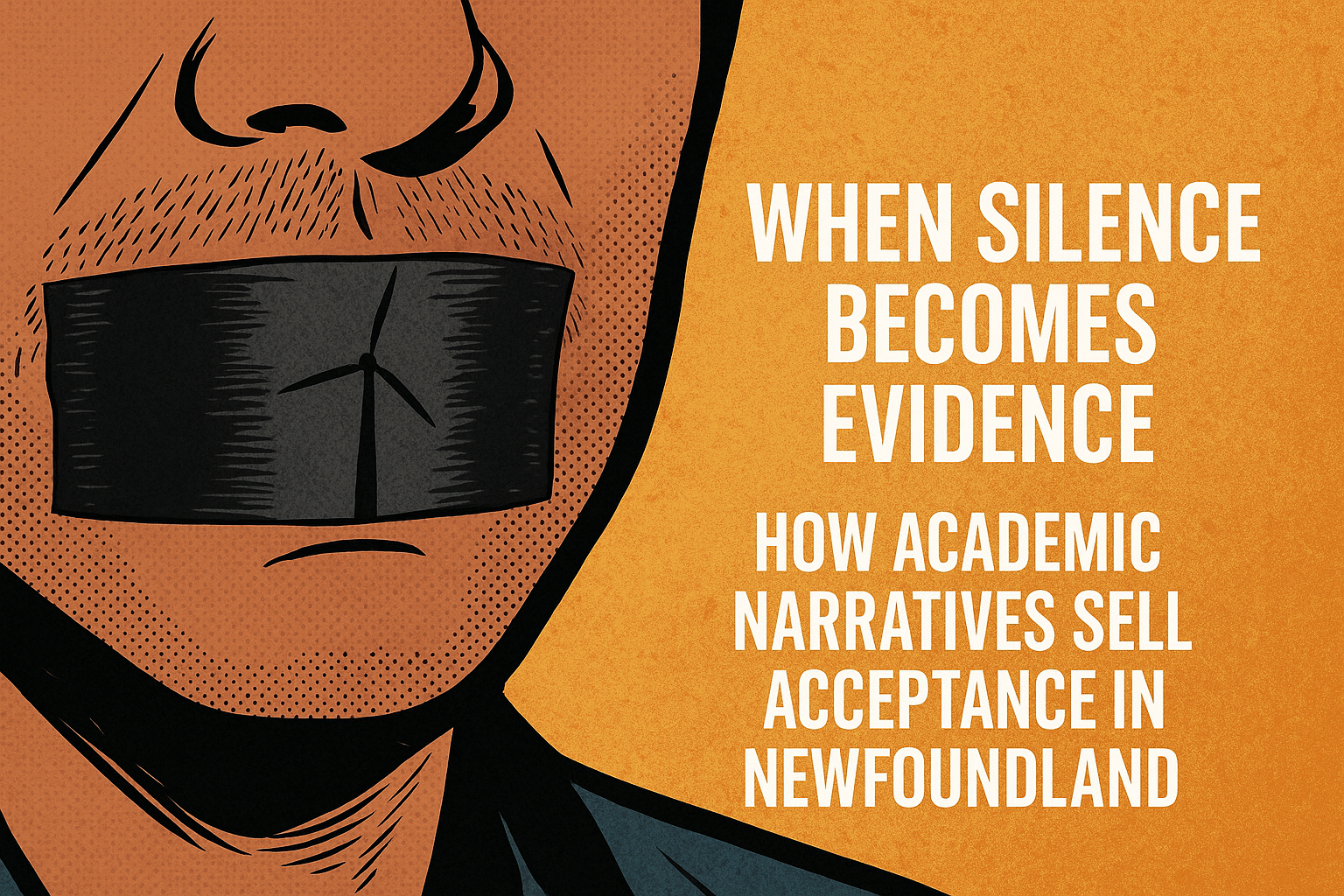When academics write about Newfoundland, they rarely begin with what life actually feels like here. They begin with frameworks, categories, and coded data that smooth the edges off local reality. The result is that silence looks like agreement, resignation looks like support, and history itself gets repurposed as proof that people are ready for the next project.
Jessica Hogan’s recent article in Energy Research & Social Science is a case study in how this happens. On paper, it is a rigorous account of “third-wave social acceptance” of renewable energy projects. In practice, it is an academic repackaging of Newfoundland’s forced dependency, presented as “evidence” of broad acceptance (Hogan 2025).
The Numbers That Make the Story
Hogan’s work is built on two data sources:
- A mail-out survey with 146 responses (25 percent return rate).
- A handful of semi-structured interviews — 6–8 per community, mostly men over 40, with only one woman interviewed per site.
The survey, conducted through Canada Post in 2021, asked residents near wind projects in Fermeuse, St. Lawrence, and Ramea to respond to statements about support and fairness. The interviews, done in 2022, were recruited by snowball sampling and ran 30–90 minutes each (Hogan 2025).
From this slender dataset, Hogan produces neat tables: 70–78 percent of respondents “support the existing wind project.” Interviews are coded into the categories of “procedural,” “distributional,” and “recognition” justice (Hogan 2025).
On the page, the results look clean. But in reality, the numbers are stretched across an entire region and made to stand for broad consensus. A return rate of 25 percent is thin by any standard. Overrepresentation of older men, coupled with the absence of younger and female voices, skews the responses. And snowball sampling guarantees a tilt toward already-engaged participants. What looks like consensus is, at best, a partial snapshot.
Coping Reframed as Consent
The heart of Hogan’s interpretation lies in what she calls “recognition justice.” Communities, she argues, see wind projects as fair because they recognize them in contrast to past harms.
- In St. Lawrence, where uranium and fluorspar mines left a toxic legacy, wind is seen as safe.
- In rural outports hollowed out by the cod moratorium, wind recalls the prosperity of busier times.
But this is not real consent. It is comparative coping. If your history is one of danger and collapse, then anything safer and newer looks acceptable by default. What Hogan presents as “acceptance” is really the outcome of deprivation — the embrace of whatever lifeline is offered (Hogan 2025).
This framing carries a subtle but powerful distortion. By coding trauma as recognition, resignation is repackaged as fairness. Communities that cling to projects out of necessity are reframed as supportive actors in a just transition. The very conditions that leave people powerless — collapse, outmigration, dependency — are recast as evidence that people welcome development.
The Roadmap Beside It: The Local Paradox
Now place Hogan’s work next to the Local Paradox paper, published in the Scandinavian Journal of Public Administration. Where Hogan supplies the numbers, Local Paradox supplies the theory.
The authors describe Newfoundland’s governance as too weak to resist or shape grand policy resets: “The problem of weak local governance does not only generate limited local involvement, but limited local involvement is frequently reinterpreted by government as lack of local capacity” (Van Assche, Greenwood & Gruezmacher 2022).
They go further, arguing that locals often prefer weak governance, relying instead on project-based survival strategies: “Newfoundlanders may resist governance reform as much as they resist particular development projects, while still preferring to survive by means of short-term fixes and individual coping mechanisms” (Van Assche, Greenwood & Gruezmacher 2022).
On the surface, this sounds like diagnosis. But in practice, it is prescription. For governments and industry, the message is clear: if local governance is weak, projects can always be advanced. Silence can be reframed as incapacity. Opposition can be dismissed as ignorance. Either way, the system can roll forward.
How the Two Fit Together
Here is the dangerous pairing:
- Hogan provides the statistical veneer. A handful of surveys and interviews become percentages that “prove” acceptance.
- Local Paradox provides the interpretive scaffold. Weak governance and project thinking explain why no resistance appears.
Together, they create a toolkit for legitimizing development:
- If locals are silent, call it consensus.
- If they resist, call it incapacity.
- If they cling to projects out of desperation, call it recognition justice.
The effect is not neutral. These articles do not sit idly in academic journals. They travel. They are cited in government reports, repeated in consultation sessions, and recycled by consultants who arrive with PowerPoints in hand. The same charts and coded categories that appear in peer-reviewed journals resurface as justification for the next round of projects.
The Bayman’s Paradox Counterpoint
What both articles miss is what I have called the Bayman’s Paradox: that Newfoundland is locked into a cycle where project-based survival substitutes for real strategy.
- Weak governance is not natural — it is maintained.
- Project thinking is not a cultural quirk — it is reinforced by outside managers who find it convenient.
- Silence is not consent — it is the sound of people stripped of the institutional means to say no.
The danger of academic framings like Hogan’s is that they don’t just misinterpret this silence — they actively weaponize it. A government official can now point to published numbers and say, “See, people support wind.” A developer can reference energy justice theory and claim, “We’ve been recognized.”
But the lived reality is different: acceptance often comes from resignation, dependency, or lack of alternatives. Communities accept projects not because they are empowered, but because they have no choice.
Complicity in Silence
Academic articles like Hogan’s and the Local Paradox document do more than describe. They prescribe. They become the evidence base for governments and developers, justifying the very processes they claim to analyze.
The cost of this is borne locally. Once published, these narratives enter policy cycles and consultation frameworks. They legitimize consultation theatre, where outcomes are already decided. They provide cover for governments that substitute symbolic gestures of recognition for genuine redistribution of power. And they allow industry to claim that projects have social license, even when locals feel voiceless.
In Newfoundland, what passes for acceptance is too often just the quiet sound of people stripped of real choices. To call that consent is not research. It is complicity.
See also
- Rehearsed Truth: How Repeating the Same Story Keeps Newfoundland Stuck
- The Faux Consultation Files: When Participation Becomes Performance
References
[1] Hogan, J. L. (2025). The legacy of the cod fishery collapse: Understanding wind energy acceptance in Newfoundland through energy justice and place. Energy Research & Social Science, 127, 104274. https://doi.org/10.1016/j.erss.2025.104274 (Local Download)
[2] Van Assche, K., Greenwood, R., & Gruezmacher, M. (2022). The local paradox in grand policy schemes: Lessons from Newfoundland and Labrador. Scandinavian Journal of Public Administration, 26(1), 25–51. https://www.sciencedirect.com/science/article/abs/pii/S0956522122000197?via%3Dihub (Local Download)

